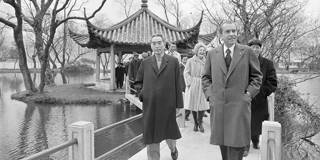Revisionist critics argue that the US president’s 1972 visit to China, far from being a diplomatic masterstroke, was a huge strategic blunder. But a policy of engagement that helped produce 40 years of peace, prosperity, and stability between two former staunch foes must be considered a resounding success.
CLAREMONT, CALIFORNIA – With China currently the only country capable of unseating America as the leading global power, many in Washington may wish that US President Richard Nixon had never made his historic trip to China 50 years ago this month. In their revisionist narrative, it was Nixon’s meeting with Communist Party of China Chairman Mao Zedong, and the policy of engagement it initiated, that helped make China an economic superpower and a geopolitical threat to America. For these critics, the Nixon visit, far from being a stroke of diplomatic genius, was one of history’s greatest strategic blunders.
But such revisionist arguments discount the substantial benefits the United States gained from Nixon’s gambit and the decades of US-China engagement that followed. Although China did not directly assist the US, Nixon’s visit shifted the perceived Cold War balance of power and influenced the strategic calculations of both the Soviet Union and North Vietnam, resulting in immediate US gains. America and the Soviet Union signed the first nuclear arms control treaty (SALT I) in May 1972, and the US extricated itself from Vietnam a year later.
Engagement with China also yielded significant longer-term geopolitical and economic dividends for the US. Regional tensions in East Asia eased dramatically, mitigating the Chinese threat to vital US interests there, while the US-China quasi-alliance against the Soviet Union in the 1980s contributed to America’s victory in the Cold War.

CLAREMONT, CALIFORNIA – With China currently the only country capable of unseating America as the leading global power, many in Washington may wish that US President Richard Nixon had never made his historic trip to China 50 years ago this month. In their revisionist narrative, it was Nixon’s meeting with Communist Party of China Chairman Mao Zedong, and the policy of engagement it initiated, that helped make China an economic superpower and a geopolitical threat to America. For these critics, the Nixon visit, far from being a stroke of diplomatic genius, was one of history’s greatest strategic blunders.
But such revisionist arguments discount the substantial benefits the United States gained from Nixon’s gambit and the decades of US-China engagement that followed. Although China did not directly assist the US, Nixon’s visit shifted the perceived Cold War balance of power and influenced the strategic calculations of both the Soviet Union and North Vietnam, resulting in immediate US gains. America and the Soviet Union signed the first nuclear arms control treaty (SALT I) in May 1972, and the US extricated itself from Vietnam a year later.
Engagement with China also yielded significant longer-term geopolitical and economic dividends for the US. Regional tensions in East Asia eased dramatically, mitigating the Chinese threat to vital US interests there, while the US-China quasi-alliance against the Soviet Union in the 1980s contributed to America’s victory in the Cold War.